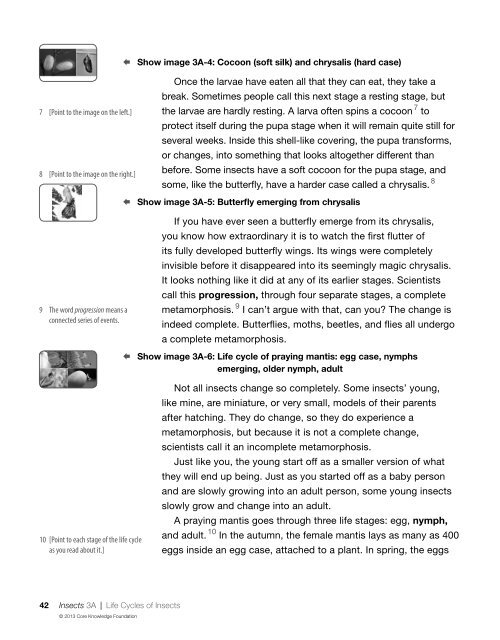Read-Aloud Anthology - EngageNY
Read-Aloud Anthology - EngageNY
Read-Aloud Anthology - EngageNY
You also want an ePaper? Increase the reach of your titles
YUMPU automatically turns print PDFs into web optimized ePapers that Google loves.
Show image 3A-4: Cocoon (soft silk) and chrysalis (hard case)<br />
7 [Point to the image on the left.]<br />
8 [Point to the image on the right.]<br />
Once the larvae have eaten all that they can eat, they take a<br />
break. Sometimes people call this next stage a resting stage, but<br />
the larvae are hardly resting. A larva often spins a cocoon 7 to<br />
protect itself during the pupa stage when it will remain quite still for<br />
several weeks. Inside this shell-like covering, the pupa transforms,<br />
or changes, into something that looks altogether different than<br />
before. Some insects have a soft cocoon for the pupa stage, and<br />
some, like the butterfly, have a harder case called a chrysalis. 8<br />
Show image 3A-5: Butterfly emerging from chrysalis<br />
9 The word progression means a<br />
connected series of events.<br />
If you have ever seen a butterfly emerge from its chrysalis,<br />
you know how extraordinary it is to watch the first flutter of<br />
its fully developed butterfly wings. Its wings were completely<br />
invisible before it disappeared into its seemingly magic chrysalis.<br />
It looks nothing like it did at any of its earlier stages. Scientists<br />
call this progression, through four separate stages, a complete<br />
metamorphosis. 9 I can’t argue with that, can you? The change is<br />
indeed complete. Butterflies, moths, beetles, and flies all undergo<br />
a complete metamorphosis.<br />
Show image 3A-6: Life cycle of praying mantis: egg case, nymphs<br />
emerging, older nymph, adult<br />
10 [Point to each stage of the life cycle<br />
as you read about it.]<br />
Not all insects change so completely. Some insects’ young,<br />
like mine, are miniature, or very small, models of their parents<br />
after hatching. They do change, so they do experience a<br />
metamorphosis, but because it is not a complete change,<br />
scientists call it an incomplete metamorphosis.<br />
Just like you, the young start off as a smaller version of what<br />
they will end up being. Just as you started off as a baby person<br />
and are slowly growing into an adult person, some young insects<br />
slowly grow and change into an adult.<br />
A praying mantis goes through three life stages: egg, nymph,<br />
and adult. 10 In the autumn, the female mantis lays as many as 400<br />
eggs inside an egg case, attached to a plant. In spring, the eggs<br />
42 Insects 3A | Life Cycles of Insects<br />
© 2013 Core Knowledge Foundation

















